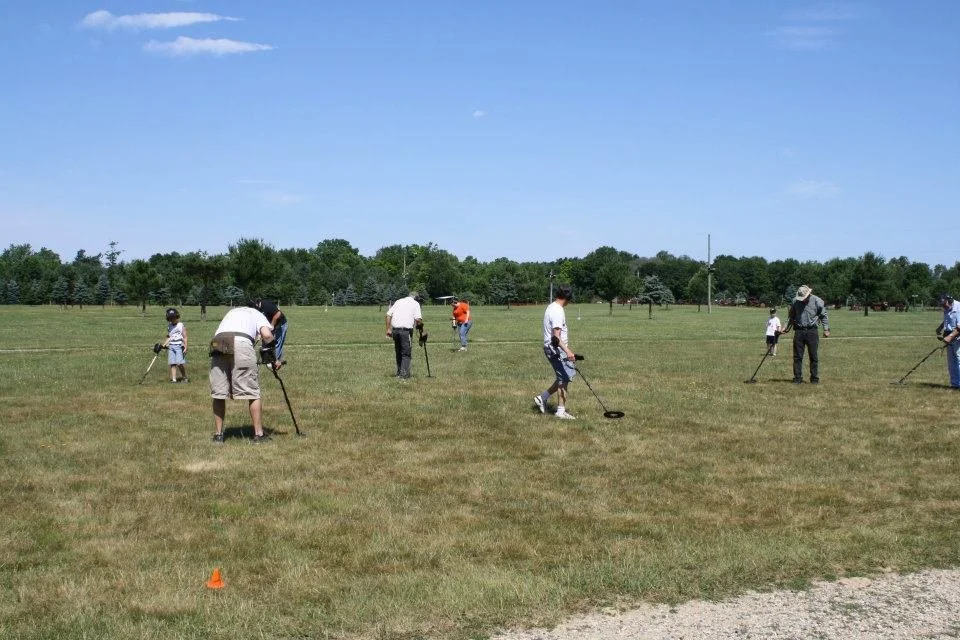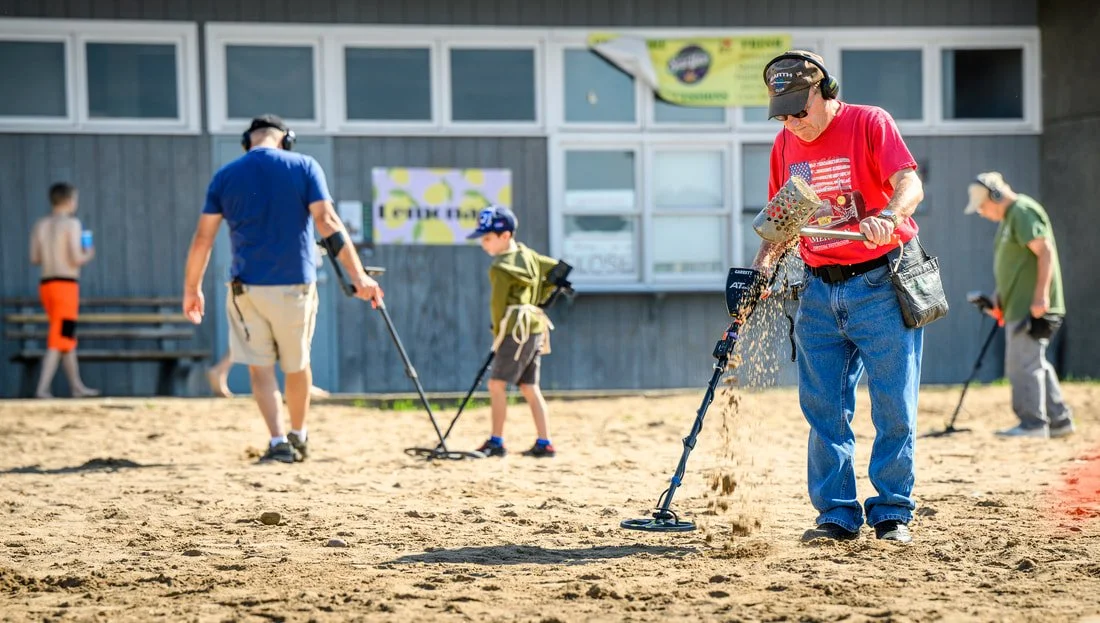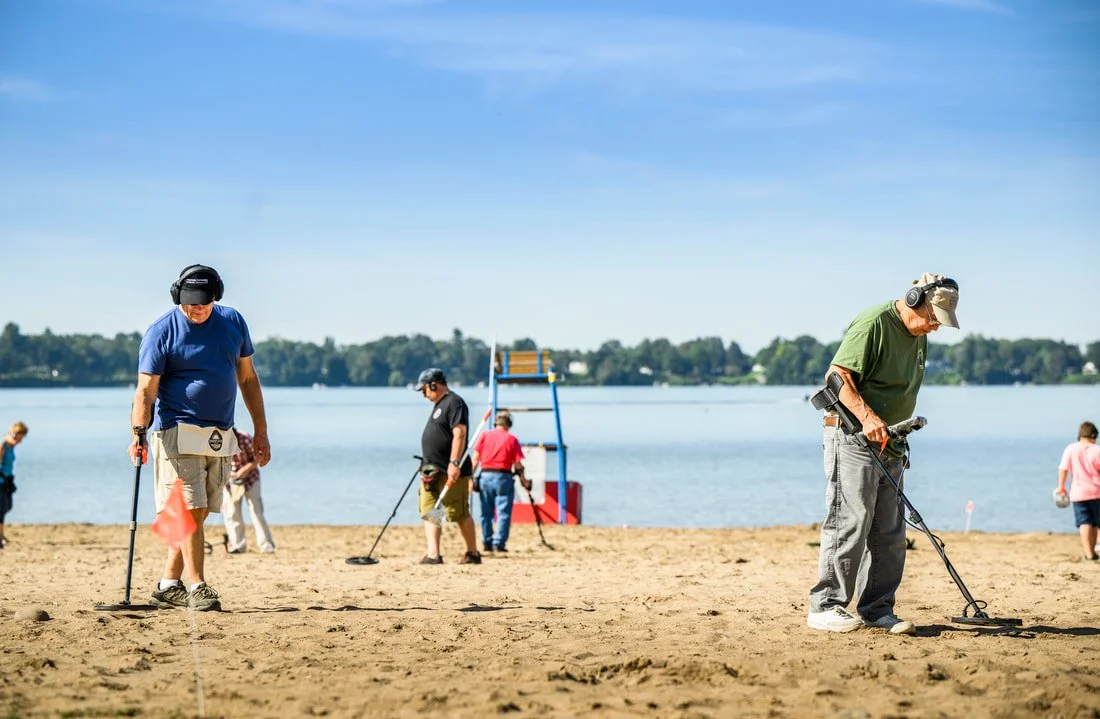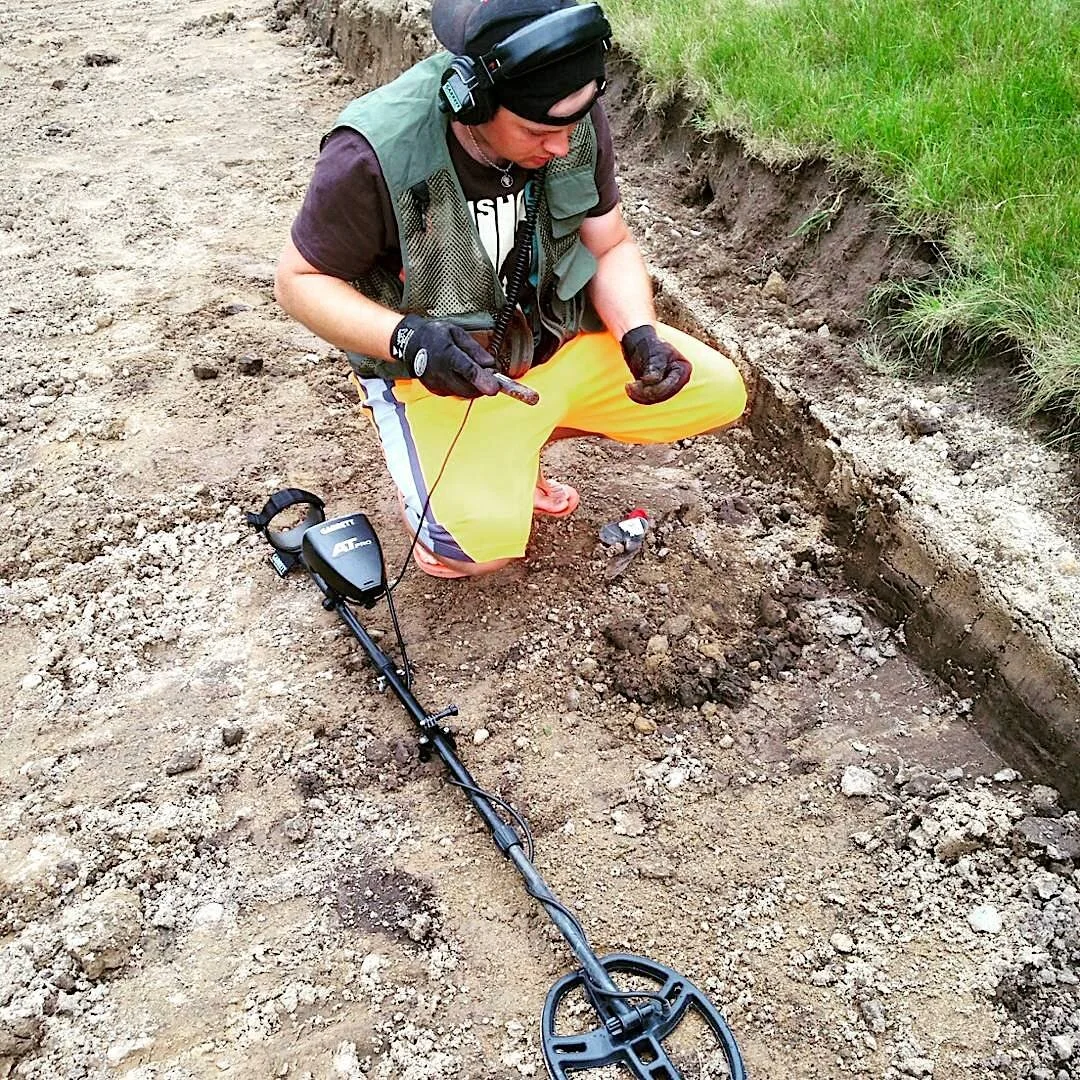What Is A Seeded Hunt?
Many people consider metal detecting just a hobby… A hobby that is mainly done by retired or elderly people.
But what if metal detecting was actually more than a hobby? What if metal detecting was a sport? A sport where metal detecting became a competition where “winners really do try to take all!”
Thus, I give you a metal detecting seeded hunt!
**DISCLAIMER - As an Amazon Associate I earn from qualifying purchases. The links in the article are affiliate links that help support this blog and my channels. Metal Detecting Life is supported by you, the readers! When you purchase something I recommend via my links, I may get an affiliate commission (terms of service) — but it never affects the price you pay. Cheers!
What Is A Seeded Hunt?
A seeded hunt is a metal detecting event where coins, tokens, and other various targets are purposely planted or hidden just below the surface by a hunt master and those items are then meant to be found by other metal detectorists.
Seeded hunts may have a time limit as each detectorist races at the same time to recover those hidden targets within the marked area or until all targets have been found.
Seeded hunts are a great event for the entire family and can be for all ages as there are often both hunts for adults and kids.
12 factory settings allow you to have so much flexibility while you are looking for treasure underground including waterproof up to 20m.
Whether you hunt at the beach for gold chains or prefer hunting for old coins and relics around homesteads, there is a setting that can help you with the XP Deus II
Where To Find A Seeded Hunt?
If you are looking to participate in a seeded hunt, you can most likely find them taking place throughout the year by joining a local metal detecting club, an article that I wrote previously that also provides a few extra benefits on why you should join a club, just in case you haven’t already joined one. Local clubs often host at least one to two seeded hunts each year.
Seeded hunts are a great form of fellowship for clubs and are a wonderful way to bring metal detectorists and treasure hunters together to talk about best detecting practices and ways to research new spots to detect, which are both very helpful articles that were recently published, demo new products, and of course, to share a few laughs and tall tales of finding treasure.
These seeded hunts by local clubs are great for beginner hunters when it comes to competitive hunting because they usually contain less than 100 people detecting per hunt, so you’re likely to find plenty of targets.
GoMinelabbing events often have seeded hunts that can be found all over the world for detectorists to participate.
To participate in larger seeded hunt competitions, you can search for events in several locations online. Forums or Facebook groups will usually have a section that contains information on seeded hunts and group outings that welcome metal detectorists from all over to join in on the fun.
Searching various metal detecting company websites may also reveal an events page that will include planned seeded hunts throughout various regions during the year and who knows, maybe one will be coming to a town near you!
Is There A Cost For Seeded Hunts?
The Charles Garrett Memorial Hunt is held annually courtesy of Garrett Metal Detectors. (Photo credit: Garrett Metal Detectors)
The line for the included lunch at a GoMinelabbing seeded hunt.
Typically there is a small fee to participate in a seeded hunt.
The price to participate can range anywhere from $10 - $100 for a seeded hunt event, although some are indeed free or may be covered by your metal detecting club membership dues.
This cost goes towards purchasing extra coins and targets to be found throughout the hunt. It may also cover raffle and door prizes that are given away to lucky hunters who find a special token out in the hunt field.
Finally, some seeded hunts even have a break for lunch so make sure to check the details to see if lunch and/or dinner is included in the price of admission or if it will be a potluck meal.
All the coins I found during a seeded hunt in Toronto, Canada.
The good news is that if you are worried about the cost, you’ll most likely be able to make some of your event fee back from the coins and/or raffle prizes you could potentially win.
The first few seeded hunts I participated in, I was able to recoup my entry fee of $25 by finding enough silver coins throughout the day that I ended up with just over $60 in silver and even won a raffle by finding a special token that netted me a gift bag of detecting gear!
While this may not always be typical for everyone, it is a possibility and that is why some detectorists view seeded hunts as a sport or competition, because there can be profit and value to be had from what you find as well as what door prizes and raffles the hunt may include.
What Metal Detector Do I Use During A Seeded Hunt?
Giveaways and prizes like this are common at many metal detecting seeded hunts. Photo Credit: Beaver County Detecting Club
Knowing now that seeded hunts can be a bit more competitive, many detectorists come up with their own unique strategies to try and improve their odds of finding more or better targets during a seeded hunt. One of those strategies is picking the right metal detector to use during your seeded hunt.
Use A Lightweight Metal Detector
The XP Deus II is one of the lightest detectors on the market, but still packs a powerful punch.
During a seeded hunt, speed is the name of the game and trying to swing a metal detector that is bulky and heavy won’t serve you very well.
For instance, trying to swing a White’s MXT that weighs over 4lbs or even worse, a Minelab CTX 3030 at over 5lbs, which I just recently purchased for myself (but not for a seeded hunt), can really tire you out quickly during a hunt.
Using a detector that is lightweight such as a Tesoro Compadre, makes it a dream to swing with the stock coil, as it comes in at just under 2lbs!
Another lightweight option to use during a seeded hunt would be using an XP Deus as it is just over 2lbs and has a wireless headphone option so that you don’t have to worry about any cables getting in the way as you detect and dig your targets.
Basic Is Best
If you can find a Tesoro metal detector like this Silver Umax, they can be great machines for seeded hunts. (My very 1st metal detector)
I have found that using a detector that is very basic and isn’t utilizing various frequencies or computer programs works best during a seeded hunt, just like the Tesoro Silver Umax pictured here and was also my very 1st metal detector.
Often times when there are 100+ metal detectors within close proximity to one another and all on the same frequency, you can start to hear the interference in your headphones and it makes it difficult to hunt or hear your targets. That is why most hunts require you wear headphones while participating.
What’s a good example of a basic detector that won’t have this issue? Well, we’re back to the Tesoro brand.
With a limited interface for knobs and often times powered by one 9v battery, Tesoros are truly basic and simple, yet a very powerful machine for competition based seeded hunts.
The one downfall is that Tesoro as a brand has been discontinued and is no longer in business, so you’ll most likely have to find them used and/or on eBay or Facebook marketplace.
You can search for variations of the Tesoro brand such as the Silver Umax, Cibola, Vaquero, and Tejon to name a few, just in case you cannot find a Compadre, which is the most basic of units.
Sand or Grass Seeded Hunts?
Club seeded hunts are a great way to introduce fun competition amongst club members. Photo Credit: West Michigan Detector Club
Knowing whether your seeded hunt will be held in sand (beach) or grass (field) will also play an important role in how you’ll want to attack the competition. Things to keep in mind may include the type of detector you hunt with, the type of digging tool needed, and various accessories to help you recover and store your targets as you hunt.
Sand Seeded Hunts
Participants in a seeded hunt on the beach. Photo credit: Nathan Schwenke - Midwestdiggers
Having a good scoop during a beach hunt is vital to your success. Photo Credit: Nancy Ford - EARTH Metal Detecting Club
If your seeded hunt will be taking place in the sand, perhaps at a local beach, you’ll want to be sure to have something that can sift that target from the sand.
It is important to have a sifter or scoop that has holes large enough to allow that sand to flow through quickly, but not too large because you don’t want to lose your target through it. This could be a handheld scoop from the treasure kit or you could even make your own like I did from plastic drink pitchers.
As you begin to accumulate targets, you’ll also want a good pouch or bag to be able to quickly put your finds in as you continue digging. The tricky part about participating in a seeded hunt held on a beach is that your finds bag will likely also start to fill with sand, especially depending on your scoop or recovery method.
Using a mesh bag like these on Amazon, which is what I always use when hunting the beach or water, could pay dividends because as you continue to detect, and remaining sand will filter out, all the while keeping your targets safe from falling through.
Other things to think about when participating in a seeded hunt on sand is what to wear. Tennis shoes could quickly fill up with sand as you walk around and may actually slow you down as you hunt. Sandals may seem ideal for any beach outing, but in this case, may slide off your feet as you rush around looking for targets.
Sand socks add an extra layer of protection while out metal detecting.
My recommendation would be to use something like a dive boot or sand socks as either of these will not only protect your feet, but also help keep sand from accumulating inside them because they are form-fitting and can be found for a very reasonable price on Amazon.
I use my dive boots and sand socks exclusively when doing any type of beach hunting and they have saved me countless times from stepping on unwanted material and even protected my feet during those days when the sand is piping hot! The only thing you’ll have to deal with is having some wicked tan lines on your legs!
Grass Seeded Hunts
Seeded hunts taking place in the grass present their own unique sets of challenges. Photo Credit: West Michigan Detector Club
Having a seeded hunt in a grassy area or field presents a new set of challenges when trying to recover targets. Unlike the sand, you are not able to quickly scoop, recover, and move on when hunting in the grass.
Usually the hunt master will push the coins or target just below the surface of the soil, so while you may not have to read the article on how to cut a plug in order to recover your target, you may need to be able to pop it from the soil. This can be done with a coin probe or flathead screwdriver relatively quickly.
One other useful tool you may want to bring along when participating in a seeded hunt that is taking place in a grassy field is your pinpointer as it will also help you from digging unnecessary plugs. In fact, once you swing over a target, pulling out your pinpointer and quickly scanning the ground where you heard the signal will most likely be enough to locate it as it won’t be buried very deep, if at all, below the soil.
Strategy For Searching The Hunt Field During A Seeded Hunt
Regardless on what type of terrain your seeded hunt takes place in, one thing is common when it comes to how 95% of the participants start their hunt. They all race to the middle of the hunt field.
Why is this important to know or consider when it comes to planning your own hunt strategy? Well, if everyone races right in to the middle, what does that mean for the outer edges of the hunt field? IT IS VIRGIN GROUND!
Hunting along the edges can yield many targets that other hunters pass over as they rush the middle of the hunt field. Photo Credit: Nancy Ford - EARTH Metal Detecting Club
Think about that for a minute. With everyone pouring in to the middle, they’ve effectively left the outer third completely untouched. Now, with any good hunt master, they will have seeded all over the field and here’s a pro tip for you: many of those hunt masters like to get sneaky and hide plenty of targets right along the very edges and corners of the marked hunting area, so be sure to walk those lines.
I know some very successful hunters who let everyone run to the middle and then they simply turn and start detecting those edges right away because they know everyone walked right over it, leaving all those targets ripe for the picking and they’re the only one hunting that area because they have it all to themselves.
If you do choose to be in the thick of the action and want to head to the middle, then just be sure you’re the first one out there once the horn sounds so you can stake your claim because the early bird will find the treasure in this instance. However, remember targets will and should be hidden all over the field, so no matter where you go, you should be able to at least find a few hidden gems!
Dig And Go - Speed Is Key In Seeded Hunts
Detectorists scour the beach in this seeded hunt picking up coins as fast as they can. Photo Credit: Nancy Ford - EARTH Metal Detecting Club
It will be very tempting to look at and inspect every find you recover, but I encourage you to not do this until you’re off the hunt field and finished detecting. This is because every second counts during these hunts and if you are waisting time admiring your latest recovery, other detectorists will begin to swarm your area because they noticed you just found something and so they will think there must be more close by. If you are kneeling down looking at your find, you’ll be giving up that precious time and real estate around you.
These stylish sandals found on Amazon may look cool, but they’ll only slow you down if you’re trying to “dig and go.”
The best strategy to employ for recovering targets during a seeded hunt is too “dig and go!”
As soon as you scoop up your target, drop it in to your recovery bag without looking at it and keep swinging your detector, listening for the next signal to recover.
Seeded hunt competitions are a game of speed, so the faster you are with this process, the better your odds will be for finding more prizes.
Summary
Plenty of friends were made at the GoMinelabbing seeded hunt.
Seeded hunt competitions certainly offer a good alternative for those hobbyists looking to switch up their metal detecting experience. Seeded hunts allow detectorists to be able to scratch that competitive itch, but also helps provide an outlet for those of us that enjoy the hobby so that we are be able to come together and talk all things detecting while partaking in some good ole’ fellowship.
Even if you don’t like competing in seeded hunts, they can make for a great spectating sport, almost like the Super Bowl of metal detecting! Regardless of your preference on seeded hunts, there is something for everyone, so be sure to come out to one and prepare to have a great time!
Have you participated in a seeded hunt before? If so, tell me about it in the comments or shoot me an email by leaving a beep.
*I may earn a small commission from affiliate links in this article.

























